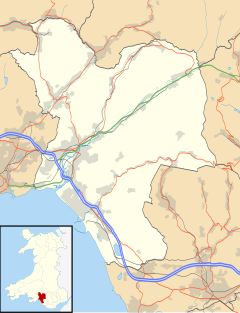Cilybebyll
| Cilybebyll | |
|---|---|
 St John the Evangelist's church |
|
| Cilybebyll shown within Neath Port Talbot | |
| Population | 4,769 (2001) |
| OS grid reference | SN7404 |
| Community |
|
| Principal area | |
| Ceremonial county | |
| Country | Wales |
| Sovereign state | United Kingdom |
| Post town | NEATH |
| Postcode district | SA8 |
| Dialling code | 01792 |
| Police | South Wales |
| Fire | Mid and West Wales |
| Ambulance | Welsh |
| EU Parliament | Wales |
| UK Parliament | |
| Welsh Assembly | |
Cilybebyll /ˌkɪləˈbɛbɪl/ is a village and community in Neath Port Talbot County Borough in Wales. It includes the villages of Alltwen, Fforest Gôch, Gellinudd and Rhos, and is located 1.9 miles (3.1 km) east of Pontardawe, 4.7 miles (7.6 km) north of Neath and 10.3 miles (16.6 km) north east of Swansea. The community has a population of 4,806.
The Cilybebyll estate was established in the 15th century, and after development by various families, by 1838 was recorded as having the largest land holding in the district. The main house, Plas Cilybebyll, was redeveloped in 1840 by Henry Leach, creating a south-facing Victorian facade on the property. His son Frances Edward Leach inherited the estate in 1848, changing his name to Lloyd in 1849 by Royal Charter in order not to forfeit his inheritance. The family remained in residence until the early 20th century, when the family records were passed to Swansea Museum. The main house today is a guest house.
Like much of South Wales, small-scale coal mining has taken place in the area for many centuries. By 1849 it was producing large quantities of coal, which were readily transported around the world from the docks at Swansea. The dangers of coal mining past and present are highlighted by two disasters in the locality. In 1858, 14 men and boys died as a result of engine fumes being accidentally pumped into the Primrose Colliery. In 2008 the community council commemorated the 150th anniversary with a plaque on a park bench.
On 15 September 2011, water poured into the mine workings at Gleision Colliery, a small scale colliery which had expanded as the price of anthracite had risen. Three miners escaped to the surface, with one taken to Morriston Hospital. Units from the Mines Rescue Service were called in from across the United Kingdom, to rescue four men located 90 metres (300 ft) below the surface. Four bodies were subsequently found. Parallel inquiries into the causes of the disaster were launched by South Wales Police and the Health and Safety Executive.
...
Wikipedia

